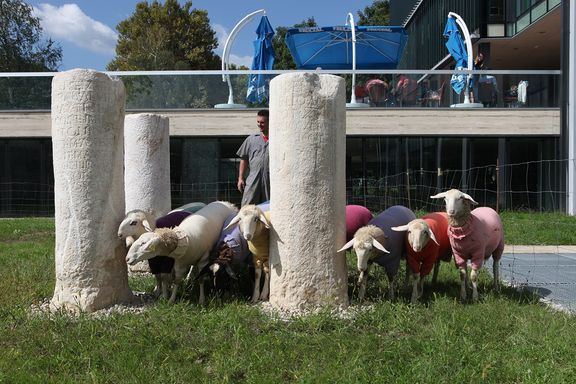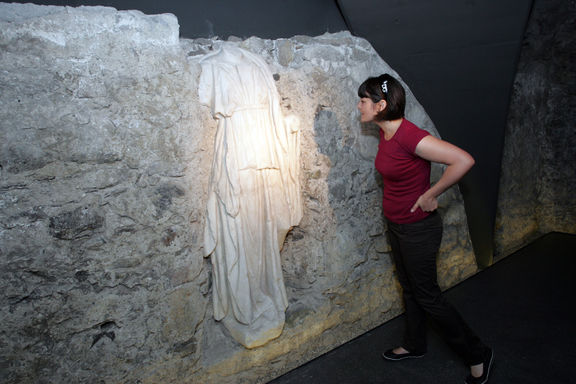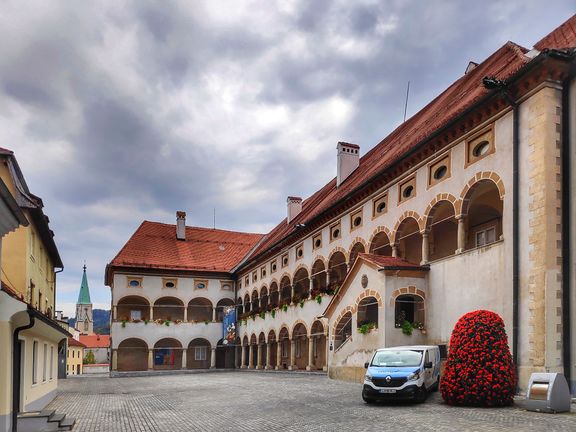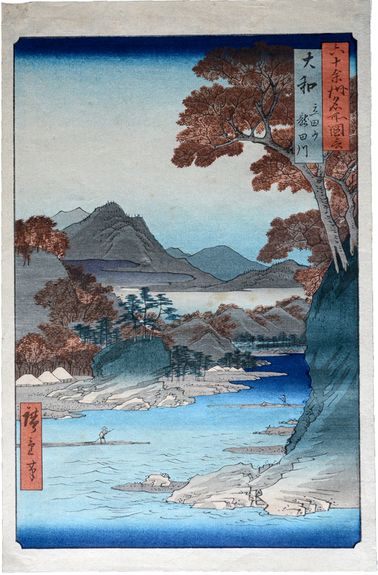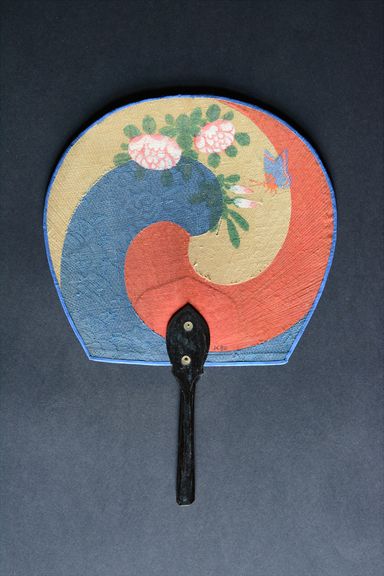Celje Regional Museum
-
to
15 Sep 2023
23 Nov 2023
Exhibition "Alma Maksimilijana Karlin - Authoress", showcasing the writer's life and work. In the scope of Slovenia – Guest of Honour Country at the Frankfurt Book Fair 2023 and made possible by Municipality of Celje, Slovenian Book Agency, Celje Regional Museum, Celje Museum of Recent History and Slovene Ethnographic Museum.
at the Frankfurt Book Fair
-
to
16 Sep 2021
18 Jan 2022
Alma M. Karlin - Alone Around the World, an exhibition prepared by the Celje Regional Museum, supported by the Ministry of Culture and Embassy of the Republic of Slovenia Vienna
-
to
5 May 2015
12 May 2015
ABC Arhivska Barbara Celjska, an exhibition from the collections of the Historical Archives Celje and Celje Regional Museum
Collections
The first part of the collection occupies an area of 240 square metres and presents eras from the Stone Age Potočka zijalka on Olševa to the late Roman period and the city of Celeia. A Roman lapidary collection with an area of 440 square metres in the cellars of the Old Counts' Mansion is supplemented with the outdoor lapidary collection of architectural remains of public and private buildings and a rich collection of milestones.
In the Major Hall, the famous Celje Ceiling in tempera on canvas (14.45 x 9.7m) is a singular example of secular painting from the turn of the 16th and 17th centuries in Slovenia. The museum also houses important Renaissance, Baroque, Rococo, Classicist, Empire, Biedermeier and Historicist paintings, sculpture, frescoes, furniture and furnishings, clocks, miniatures and portraits. One of the highlights of the Celje Regional Museum's permanent exhibition is the glass case with the skulls of the notorious Counts of Celje, previously burried beyond the main altar of the St. Mary church.
The ethnological collection on the ground floor features a wide spectrum of exhibits belonging to the material and spiritual culture of the population of the wider Celje region (ploughing implements, small agricultural tools, milk processing implements, accessories for processing flax and wool, small kitchen utensils, lights and textiles, woodworking products) and a collection of folk art.
The museum has over 370 beehive panels from the Zadrečka dolina and Savinja valleys. The numismatic collection covers an area of 60 square metres and the period from the Late Iron Age until the 20th century. Celje is the only town in Slovenia that had its own mint twice in the course of two millennia (in the 1st century BCE under the Kelts and again in the 15th century). The collection of old Savinja ceramics in the museum is one of the most exquisite and richest collections in Slovenia; it presents products from various ceramic factories established in the 19th century. A special 53 square-metre area on the ground floor of the Old Count's Mansion is dedicated to Alma Karlin, a best-seller writer and intellectual born in Celje in 1889, who studied languages in London and brought back a substantial collection of objects from her extensive journeys around the world.
Dislocated units
Archeological sites
Except from the Princely Palace archaeological remains of ancient Celeia and Old Counts’ Mansion lapidary under or in the premises of museum. The museum’s satellite archaeological sites include the Early Christian Baptistery dating from the 5th century CE; restored remains of from the 2nd century CE located on a terrace above the river Savinja's left bank Temple of Hercules on Miklavški hrib, Rifnik Archaeological Site that has findings presented in neighbouring town of Šentjur on display called Rifnik and its Treasures, The Šentjur Museum Collection; one of Slovenia most preserved archaeology highlights is definitely Šempeter v Savinjski Dolini Roman Necropolis showing graveyard of rich Roman inhabitants Living in Celeia (96–235 AD)in the time of Traian and Severan Dinasty; important palaenteologic and archaeologic site is Potočka Zijalka Paleolithic Cave cave under Olševa mountain where bones of 40 different animal species from the stone age and hunting weapons were found that are on display in the permanent exhibition Potočka zijalka, Firšt Exhibition Room in Solčava, Logarska Dolina.
Museums
The museum’s dislocated collections and historical sites include The Leber Carriage Depot at the Dobrna Museum Collection. Located in old Horse Stables in spa town of Dobrna, the museum presents collection of carriages. The Schwentner House, The Vransko Museum Collection, Vransko is a homestead of Lavoslav Schwentner (1865–1952) famous librarian and publisher from Ljubljana that was born in Vransko. He was also important maecenas of literates of Slovene Moderna. House of the Schwentner family has almost intact preserved rich bourgeois interior, furniture and equipment from the beginning of 20th century showing their lifestyle.
The Šmid Ethnological Collection, The Planina Museum Collection, Planina pri Sevnici presents ethnological collection of Janez Šmid, who was dedicated to preserve Kozjansko heritage of everyday life. The "Glaziers'" Church, The Šentjur Museum Collection, Loka pri Žusmu is a church of St. Leopold museum of glass products and crafts that were made in private glasshouses in Kozjansko region from 17th century on.
The Birthplace of Risto Savin, The Žalec Museum Collection, Žalec homestead of important Slovene composer and army officer that composed operas and ballets based on stories from national history and literature for instance operas Poslednja straža (1898), Lepa Vida (1907), Matija Gubec (1923) and ballet Čajna punčka (1922). The Gornji Grad Ethnological Collection, The Gornji grad Museum Collection presents ecclesiastical history of Slovenia, ethnological and palaeontological collections.
Temporary exhibitions
In honour of Alma M. Karlin's 120th anniversary of birth Alma M. Karlin Journey exhibition is on display until 2012. Also book on her life has been published by the museum for the occasion.
Other previous temporary exhibitions include a survey on rare culture heritage of medieval paving stones collected from monasteries, castles and churches in Slovenia Medieval floor tiles in Slovenia (2010), The Sanctuaries on the Riverside was an archaeological exhibition on Celtic and Roman cults in Celeia, and the exhibition of the museum's glass collection Mohn & Kothgasser, Transparent-enamelled Biedermeier Glass (2010).
In Strmol Manor, Rogatec some 40 km from Celje a travelling exhibition Cookery Book is on display showing recipes, kitchenware and how and what our grand grand mothers were cooking in 19th and beginning of 20th century. Exhibitions guide is an interesting cookbook presenting collection and old receipts.
Colaborations and Awards
Traditionally from 1989 on [Celje Regional Museum] collaborates with Verein Steiermarkisches Glaskunstzentrum und Glasmuseum, Bärnbach, Austria, where curator Jože Rataj and author Paul von Lichtenberg prepare exhibitions on glass making.
See also
- Rifnik Archaeological Site
- Šempeter v Savinjski Dolini Roman Necropolis
- Potočka Zijalka Paleolithic Cave, Olševa
- Potočka zijalka, Firšt Exhibition Room, Solčava
- The Leber Carriage Depot, The Dobrna Museum Collection
- The Schwentner House, The Vransko Museum Collection, Vransko
- The Šmid Ethnological Collection, The Planina Museum Collection, Planina pri Sevnici
- The »Glaziers'« Church, The Šentjur Museum Collection, Loka pri Žusmu
- The Leber Carriage Depot, The Dobrna Museum Collection
- Strmol Manor, Rogatec
External links
- Celje Regional Museum website (in Slovenian)
- Roman Necropolis in Šempeter
- Gornji Grad Museum Collection
References
- Alma Karlin's virtual home by Celje Central Library
- Risto Savin on Wikipedija (in Slovenian)
- Counts of Celje on Wikipedija (in Slovenian)
- Zvonka Zupanič Slavec: New Method of Identifying Family Related Skulls (pdf), a summary of a study on the Counts of Celje skulls



